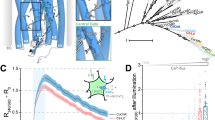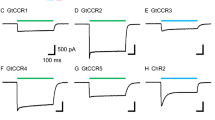Abstract
Electrically excitable cells are important in the normal functioning and in the pathophysiology of many biological processes. These cells are typically embedded in dense, heterogeneous tissues, rendering them difficult to target selectively with conventional electrical stimulation methods. The algal protein Channelrhodopsin-2 offers a new and promising solution by permitting minimally invasive, genetically targeted and temporally precise photostimulation. Here we explore technological issues relevant to the temporal precision, spatial targeting and physiological implementation of ChR2, in the context of other photostimulation approaches to optical control of excitable cells.
This is a preview of subscription content, access via your institution
Access options
Subscribe to this journal
Receive 12 print issues and online access
$259.00 per year
only $21.58 per issue
Buy this article
- Purchase on Springer Link
- Instant access to full article PDF
Prices may be subject to local taxes which are calculated during checkout


Similar content being viewed by others
References
Fork, R.L. Laser stimulation of nerve cells in Aplysia. Science 171, 907–908 (1971).
Hirase, H., Nikolenko, V., Goldberg, J.H. & Yuste, R. Multiphoton stimulation of neurons. J. Neurobiol. 51, 237–247 (2002).
Miesenbock, G. & Kevrekidis, I.G. Optical imaging and control of genetically designated neurons in functioning circuits. Annu. Rev. Neurosci. 28, 533–563 (2005).
Kramer, R.H., Chambers, J.J. & Trauner, D. Photochemical tools for remote control of ion channels in excitable cells. Nat. Chem. Biol. 1, 360–365 (2005).
Boyden, E.S., Zhang, F., Bamberg, E., Nagel, G. & Deisseroth, K. Millisecond-timescale, genetically targeted optical control of neural activity. Nat. Neurosci. 8, 1263–1268 (2005).
Li, X. et al. Fast noninvasive activation and inhibition of neural and network activity by vertebrate rhodopsin and green algae channelrhodopsin. Proc. Natl. Acad. Sci. USA 102, 17816–17821 (2005).
Ishizuka, T., Kakuda, M., Araki, R. & Yawo, H. Kinetic evaluation of photosensitivity in genetically engineered neurons expressing green algae light-gated channels. Neurosci. Res. 54, 85–94 (2006).
Nagel, G. et al. Light activation of channelrhodopsin-2 in excitable cells of Caenorhabditis elegans triggers rapid behavioral responses. Curr. Biol. 15, 2279–2284 (2005).
Callaway, E.M. & Katz, L.C. Photostimulation using caged glutamate reveals functional circuitry in living brain slices. Proc. Natl. Acad. Sci. USA 90, 7661–7665 (1993).
Zemelman, B.V., Nesnas, N., Lee, G.A. & Miesenbock, G. Photochemical gating of heterologous ion channels: remote control over genetically designated populations of neurons. Proc. Natl. Acad. Sci. USA 100, 1352–1357 (2003).
Melyan, Z., Tarttelin, E.E., Bellingham, J., Lucas, R.J. & Hankins, M.W. Addition of human melanopsin renders mammalian cells photoresponsive. Nature 433, 741–745 (2005).
Banghart, M., Borges, K., Isacoff, E., Trauner, D. & Kramer, R.H. Light-activated ion channels for remote control of neuronal firing. Nat. Neurosci. 7, 1381–1386 (2004).
Volgraf, M. et al. Allosteric control of an ionotropic glutamate receptor with an optical switch. Nat. Chem. Biol. 2, 47–52 (2006).
Nagel, G. et al. Channelrhodopsin-1: a light-gated proton channel in green algae. Science 296, 2395–2398 (2002).
Nagel, G. et al. Channelrhodopsin-2, a directly light-gated cation-selective membrane channel. Proc. Natl. Acad. Sci. USA 100, 13940–13945 (2003).
Zemelman, B.V., Lee, G.A., Ng, M. & Miesenbock, G. Selective photostimulation of genetically chARGed neurons. Neuron 33, 15–22 (2002).
Adams, S.R. & Tsien, R.Y. Controlling cell chemistry with caged compounds. Annu. Rev. Physiol. 55, 755–784 (1993).
Shoham, S., O'Connor, D.H., Sarkisov, D.V. & Wang, S.S. Rapid neurotransmitter uncaging in spatially defined patterns. Nat. Methods 2, 837–843 (2005).
Losonczy, A. & Magee, J.C. Integrative properties of radial oblique dendrites in hippocampal CA1 pyramidal neurons. Neuron 50, 291–307 (2006).
Yoshimura, Y., Dantzker, J.L. & Callaway, E.M. Excitatory cortical neurons form fine-scale functional networks. Nature 433, 868–873 (2005).
Pettit, D.L., Helms, M.C., Lee, P., Augustine, G.J. & Hall, W.C. Local excitatory circuits in the intermediate gray layer of the superior colliculus. J. Neurophysiol. 81, 1424–1427 (1999).
Callaway, E.M. & Yuste, R. Stimulating neurons with light. Curr. Opin. Neurobiol. 12, 587–592 (2002).
Lima, S.Q. & Miesenbock, G. Remote control of behavior through genetically targeted photostimulation of neurons. Cell 121, 141–152 (2005).
Qiu, X. et al. Induction of photosensitivity by heterologous expression of melanopsin. Nature 433, 745–749 (2005).
Hegemann, P., Ehlenbeck, S. & Gradmann, D. Multiple photocycles of channelrhodopsin. Biophys. J. 89, 3911–3918 (2005).
McBain, C.J. & Fisahn, A. Interneurons unbound. Nat. Rev. Neurosci. 2, 11–23 (2001).
Gong, S. et al. A gene expression atlas of the central nervous system based on bacterial artificial chromosomes. Nature 425, 917–925 (2003).
Miesenbock, G. Genetic methods for illuminating the function of neural circuits. Curr. Opin. Neurobiol. 14, 395–402 (2004).
Callaway, E.M. A molecular and genetic arsenal for systems neuroscience. Trends Neurosci. 28, 196–201 (2005).
Davidson, B.L. & Breakefield, X.O. Viral vectors for gene delivery to the nervous system. Nat. Rev. Neurosci. 4, 353–364 (2003).
Ehrengruber, M.U. et al. Gene transfer into neurons from hippocampal slices: comparison of recombinant Semliki Forest Virus, adenovirus, adeno-associated virus, lentivirus, and measles virus. Mol. Cell. Neurosci. 17, 855–871 (2001).
Zennou, V. et al. The HIV-1 DNA flap stimulates HIV vector-mediated cell transduction in the brain. Nat. Biotechnol. 19, 446–450 (2001).
Dittgen, T. et al. Lentivirus-based genetic manipulations of cortical neurons and their optical and electrophysiological monitoring in vivo. Proc. Natl. Acad. Sci. USA 101, 18206–18211 (2004).
Sena-Esteves, M., Tebbets, J.C., Steffens, S., Crombleholme, T. & Flake, A.W. Optimized large-scale production of high titer lentivirus vector pseudotypes. J. Virol. Methods 122, 131–139 (2004).
Zhao, C., Teng, E.M., Summers, R.G., Jr, Ming, G.L. & Gage, F.H. Distinct morphological stages of dentate granule neuron maturation in the adult mouse hippocampus. J. Neurosci. 26, 3–11 (2006).
Mazarakis, N.D. et al. Rabies virus glycoprotein pseudotyping of lentiviral vectors enables retrograde axonal transport and access to the nervous system after peripheral delivery. Hum. Mol. Genet. 10, 2109–2121 (2001).
Wong, L.F. et al. Transduction patterns of pseudotyped lentiviral vectors in the nervous system. Mol. Ther. 9, 101–111 (2004).
Bi, A. et al. Ectopic expression of a microbial-type rhodopsin restores visual responses in mice with photoreceptor degeneration. Neuron 50, 23–33 (2006).
Weick, J.P., Groth, R.D., Isaksen, A.L. & Mermelstein, P.G. Interactions with PDZ proteins are required for L-type calcium channels to activate cAMP response element-binding protein-dependent gene expression. J. Neurosci. 23, 3446–3456 (2003).
Garrido, J.J. et al. A targeting motif involved in sodium channel clustering at the axonal initial segment. Science 300, 2091–2094 (2003).
Farber, I.C. & Grinvald, A. Identification of presynaptic neurons by laser photostimulation. Science 222, 1025–1027 (1983).
Srinivas, S. et al. Cre reporter strains produced by targeted insertion of EYFP and ECFP into the ROSA26 locus. BMC Dev. Biol. 1, 4 (2001).
Acknowledgements
We thank C. Chan in the Gambhir lab and M. Cordey, V. Gradinaru and K. Kay in the Deisseroth lab for helpful comments and editing. This work was supported by fellowships from the US National Institutes of Health (F.Z.), California Institute of Regenerative Medicine (L-P.W.) and the Helen Hay Whitney Foundation (E.S.B.). K.D. is supported by US National Institute of Mental Health (NIMH), National Institute on Drug Abuse (NIDA) and National Institute of General Medical Sciences (NIGMS) as well as by National Alliance for Research on Schizophrenia and Depression (NARSAD), American Psychiatric Institute for Research and Education (APIRE), and the Snyder, Culpeper, Coulter, Klingenstein, Whitehall, McKnight, and Albert Yu and Mary Bechmann Foundations.
Author information
Authors and Affiliations
Corresponding author
Ethics declarations
Competing interests
The authors declare no competing financial interests.
Rights and permissions
About this article
Cite this article
Zhang, F., Wang, LP., Boyden, E. et al. Channelrhodopsin-2 and optical control of excitable cells. Nat Methods 3, 785–792 (2006). https://doi.org/10.1038/nmeth936
Published:
Issue Date:
DOI: https://doi.org/10.1038/nmeth936
This article is cited by
-
Fully bioresorbable hybrid opto-electronic neural implant system for simultaneous electrophysiological recording and optogenetic stimulation
Nature Communications (2024)
-
Switchable biomimetic nanochannels for on-demand SO2 detection by light-controlled photochromism
Nature Communications (2023)
-
Associations between in vitro, in vivo and in silico cell classes in mouse primary visual cortex
Nature Communications (2023)
-
Polydimethylsiloxane as a more biocompatible alternative to glass in optogenetics
Scientific Reports (2023)
-
Second harmonic generation microscopy: a powerful tool for bio-imaging
Biophysical Reviews (2023)



